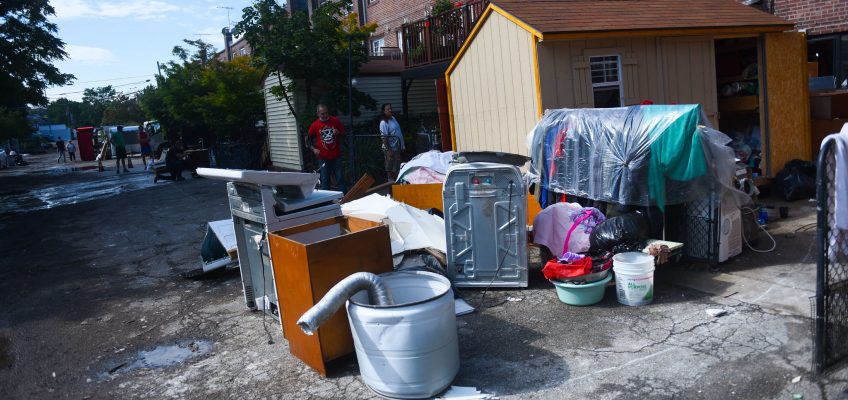Hurricane reason runs through November. “Building financial resiliency is a crucial part in preparing for climate disasters,” said Theodora Makris at the Center for NYC Neighborhoods. That can include getting flood insurance and creating an emergency fund.
Storm damage in Woodside, Queens, following Hurricane Ida in September 2021. (Michael Appleton/Mayoral Photography Office)
Hurricane season, which kicked off on June 1 and lasts until the end of November, is in full swing in the Big Apple—and it’s a good time for New Yorkers to protect their assets.
“Building financial resiliency is a crucial part in preparing for climate disasters,” said Theodora Makris, senior program manager at the Center for NYC Neighborhoods (CNYCN).
Makris explains that getting flood insurance, which you can read more about here, and creating an emergency fund ahead of the next big storm is the best way to protect your home from a severe weather event. And New Yorkers are no strangers to harsh storms.
Two torrential downpours have already descended upon New York City this summer. Last week, a forecasted two inches of rain per hour hit New York, flooding the subways and stopping traffic. A similar storm a few weeks earlier garnered shocking videos of water gushing through transit station platforms, stranding commuters on their way home from work.
This isn’t the first time New York has grappled with severe weather events. Some neighborhoods are still undergoing resiliency work stemming from the devastation of Hurricane Sandy, which struck 13 years ago this fall.
And the memory of Hurricane Ida, which landed in New York in late August of 2021 and brought over seven inches of rain over a 24-hour period to some parts of the city, is l fresh on many New Yorkers’ minds. The storm left 13 people dead, 11 of whom drowned in basement apartments.
Predictions for this year are also daunting.
The Atlantic basin will face an “above normal” hurricane season ahead according to a recent 2025 forecast report by the National Oceanic and Atmospheric Administration’s (NOAA).
The agency expects this year will bring a range of 13 to 19 total storms, with wind speeds of 39 miles per hour or higher. Of those, six to 10 are “forecast to become hurricanes” with wind speeds of 74 mph or higher,” the report notes. That includes three to five major Category 3, 4 or 5 hurricanes with winds of 111 mph or higher.
Meanwhile, the federal government has been taking funds away from the Federal Emergency Management Agency (FEMA) to protect cities across the country from major storms.
The agency just shut down its Building Resilient Infrastructure and Communities (BRIC) program, which gave New York over $380 million for key infrastructure projects to safeguard neighborhoods from climate catastrophes.
President Donald Trump also said on Truth Social that FEMA “should be terminated” as the agency “has been slow and totally ineffective,” arguing that “individual states should handle storms etc as they come” without federal support.
With shaky support on the federal level and 1.3 million New Yorkers living in or next to a floodplain, residents should have a plan in place ahead of time on how to protect themselves from future storms.
Here are some tips from the CNYCN and city agencies on what homeowners and renters can do to safeguard their homes from disaster:
Get flood insurance. The federal government is the largest U.S. provider through the National Flood Insurance Program, since few private companies offer it. Homeowners and renters alike can click here to get a quote for your property and find the best insurance for you. And here is a brochure with more information for renters who want flood insurance.
Tally up what you own. Create an up-to-date inventory of what is in your house and how much it costs. When disaster strikes, you can report the damage to the NYC Housing Recovery Portal, a resource run by the Mayor’s Office that helps New Yorkers access disaster recovery assistance to repair and rebuild their homes.
Stay informed. Sign up for weather alerts at NotifyNYC to receive updates via text whenever there is a severe event or emergency.
Assess your flood risk. If you are a low-and moderate income homeowner, use FloodHelpNY to find out (for free) how at risk you are of flooding.
Make flood-resistant upgrades. Raise mechanical equipment like HVAC systems and appliances from the floor so they don’t get ruined during a flood, and flood-seal entry points where water can seep in. Check out the state’s Resilient Retrofits program, which provides low-interest loans and grants to help homeowners in flood-prone areas safeguard their homes.
Find federal assistance after a storm hits. Although FEMA funds are drying up, if there is a presidential disaster declaration after a catastrophic weather event, then you can look up if you qualify for federal assistance here.
To reach the reporter behind this story, contact Mariana@citylimits.org. To reach the editor, contact Jeanmarie@citylimits.org
Want to republish this story? Find City Limits’ reprint policy here.
The post It’s Hurricane Season in NY. These Tips Will Help You Protect Your Home appeared first on City Limits.


Leave a Reply